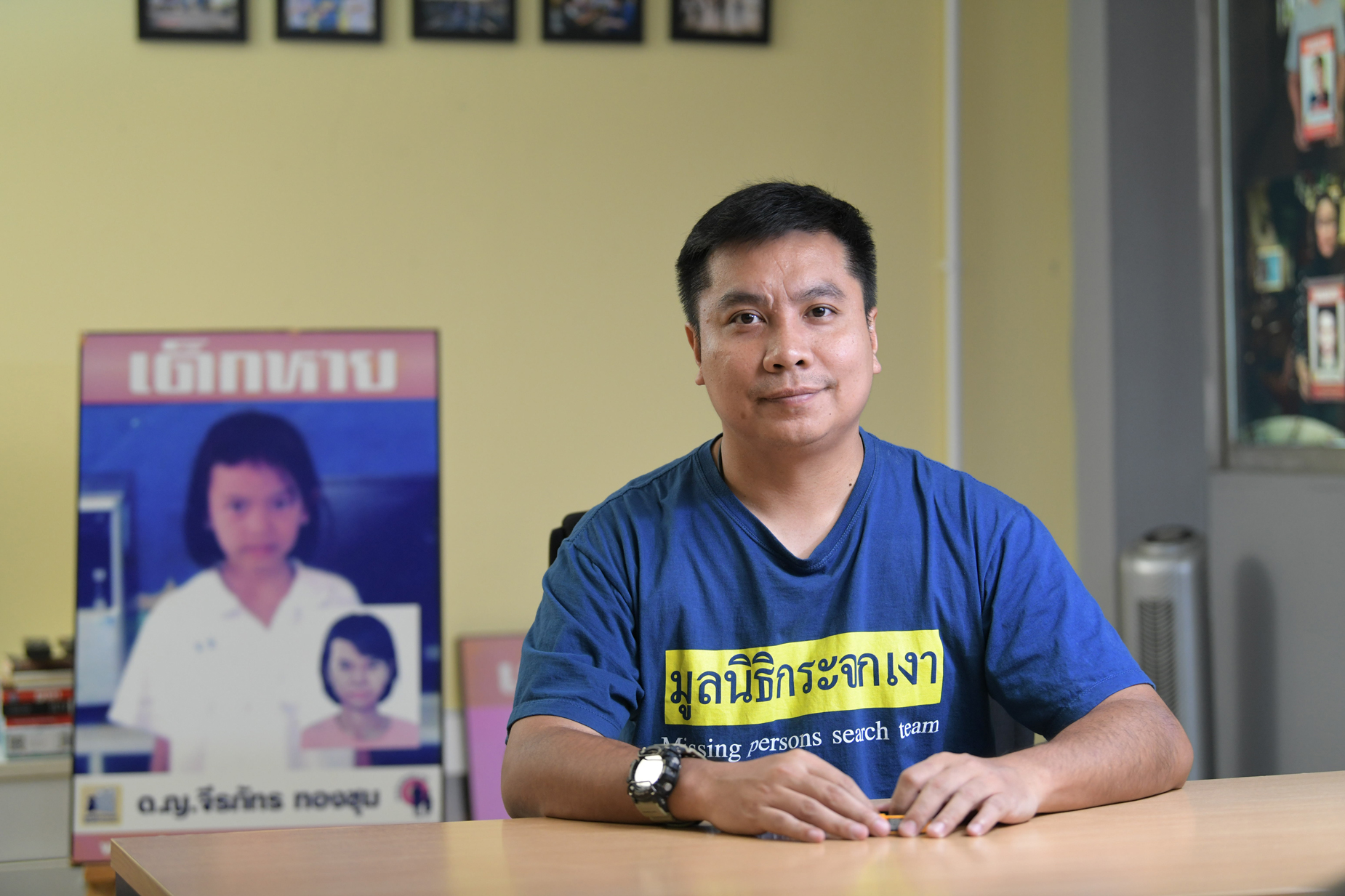
ผู้สูงอายุคือคนสำคัญในครอบครัว ที่ยังอยากใช้ชีวิตอย่างมีคุณค่าและมีความหมาย หากแต่ด้วยการเปลี่ยนแปลงตามวัย ครอบครัวจึงต้องมีความเข้าใจและหาวิธีช่วยดูแลความปลอดภัย โดยเฉพาะผู้สูงอายุที่เริ่มมีอาการหลงลืม และเสี่ยงต่อการพลัดหลงได้
เพราะคนหายเป็นเรื่องที่เกิดขึ้นกับใครก็ได้ ตามสถิติของศูนย์ข้อมูลคนหาย มูลนิธิกระจกเงา พบว่าในปี 2566 มีการแจ้งเหตุคนหายทั้งหมด 2,200 ราย ขณะที่สัดส่วนจำนวนของคนหายที่มีมากที่สุดคือ กลุ่มผู้สูงวัย ที่เวลานี้กลายเป็นประชากรกลุ่มใหญ่ของสังคมไทยตามสถิติของกรมผู้สูงอายุ โดยในปี 2566 มีจำนวนประชากรกลุ่มนี้สูงถึง 20.08% เรียกว่าเข้าเกณฑ์ สังคมสูงวัยอย่างสมบูรณ์ (Complete Aged Society)
หากเจาะลึกลงไปอีก กลุ่มผู้สูงวัยที่พลัดหลงหายไปจากบ้าน มักมีอาการหลงลืมหรือเป็นผู้ป่วยโรคสมองเสื่อม ทำให้การติดตามช่วยเหลือยิ่งเป็นไปได้ลำบาก จากสถานการณ์ดังกล่าวนี้จึงเป็นที่มาของ โครงการหาย(ไม่)ห่วง ซึ่งเป็นโครงการความร่วมมือของมูลนิธิกระจกเงาและภาคเอกชน ที่ห่วงใยและตั้งใจเข้ามาดูแลผู้พลัดหลงกลุ่มนี้โดยเฉพาะ
เอกลักษณ์ หลุ่มชมแข หัวหน้าศูนย์ข้อมูลคนหาย มูลนิธิกระจกเงา ถ่ายทอดเรื่องราวความเป็นมาของโครงการหาย(ไม่)ห่วง ที่ปัจจุบันมีผู้ลงทะเบียนกว่า 3,000 คน ในระยะสี่ปีที่ผ่านมาช่วยพาผู้พลัดหลงกลับบ้านอย่างปลอดภัยมาแล้วกว่า 40 คน และสำหรับสามเดือนแรกของปี 2567 ช่วยผู้พลัดหลงกลับสู่อ้อมอกครอบครัวมาแล้ว 15 คน
ปัญหาคนหายเป็นปัญหาใหญ่กว่าที่คิด
เอกลักษณ์ตั้งเป้าหมายของชีวิตในการทำงานเพื่อสังคมตั้งแต่เรียนจบ จากที่เคยฝึกงานเป็นทนายความ ทำให้เขาเห็นว่า วิธีที่จะช่วยเหลือคนได้เร็วที่สุดคือการเข้าไปทำงานในองค์กรเพื่อสังคม มูลนิธิกระจกเงาจึงกลายมาเป็นที่ทำงานที่แรกและที่เดียวของเขาตั้งแต่ปี 2547 จากการเริ่มเข้ามาทำหน้าที่เป็นนักกฎหมายของศูนย์ข้อมูลคนหายจากการค้ามนุษย์ ที่มีจุดเริ่มต้นจากการเห็นปัญหาเด็กหายจากการถูกหลอกไปค้าบริการทางเพศ ไปเป็นแรงงาน หรือแม้แต่เป็นขอทาน
“ในฐานะนักกฎหมาย เราก็พยายามหาช่องทางในการติดตามคนหายที่เป็นระบบมากขึ้น ในยุคนั้นมีเครื่องมือใหม่เป็นจดหมายข่าว เป็นฟอร์เวิร์ดเมลที่ส่งต่อกันว่ามีคนหาย ขณะเดียวกันก็ทำงานเชิงวิเคราะห์ข้อเท็จจริงและสืบสวน ประสานงานกับเจ้าหน้าที่ตำรวจ ติดตามผลของคดีโดยใช้แนวทางด้านกฎหมาย”
หลังจากที่ทำงานด้านติดตามคนหายมาสักพัก เอกลักษณ์ก็พบว่า ปัญหาคนหายมาจากสาเหตุมากมายเกินกว่าคาดคิด ทางมูลนิธิฯ จึงปรับการทำงานและปรับชื่อหน่วยงานเป็น “ศูนย์ข้อมูลคนหาย” ที่รับแจ้ง ปรึกษา ตามหา และติดตามปัญหาคนหายที่มีความหลากหลายในทุกรูปแบบ โดยเอกลักษณ์ก็ได้ขยับมารับหน้าที่เป็นหัวหน้างานของศูนย์นี้เช่นกัน
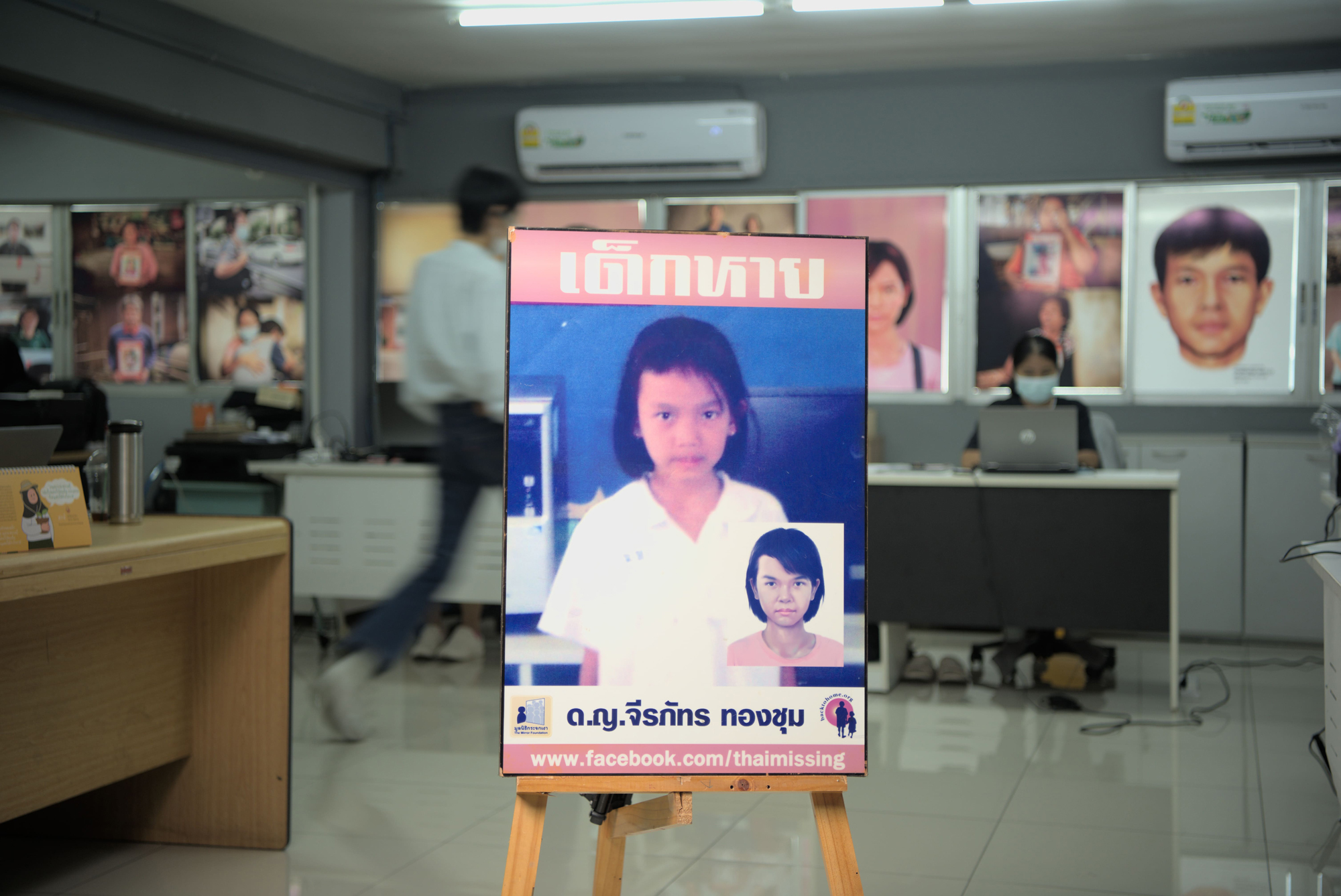
เมื่อมี Data จึงวิเคราะห์และเห็นปัญหาคนหายที่แท้จริง
“ความโชคดีคือเราทำ Database มาตั้งแต่ 20 ปีที่แล้ว เรามีระบบฐานข้อมูลบันทึกเคสคนหายทั้งหมด ข้อมูลเหล่านี้ทำให้เราเข้าใจรูปแบบของปัญหาอย่างชัดเจนว่าจริงๆ แล้วคนหายไปจากสาเหตุอะไร ซึ่งแต่ละช่วงเวลาก็มีความแตกต่างกัน” เอกลักษณ์เล่าถึงองค์ความรู้ที่ได้จากการทำงาน
การรวบรวมและวิเคราะห์ข้อมูลมาตลอดทำให้เห็นว่า แท้จริงแล้วปัญหาคนหายมีการเปลี่ยนแปลงตามสภาพเศรษฐกิจและสังคม โดยในช่วง 5 ปีมานี้กลุ่มที่พลัดหลงสูญหายส่วนใหญ่คือ กลุ่มผู้สูงวัย และผู้ป่วยจิตเวช
“ปัญหาที่เกิดขึ้นกับผู้พลัดหลงกลุ่มนี้คือ พวกเขาจะให้ข้อมูลตัวเองไม่ได้ ไม่สามารถบอกได้ว่าตัวเองเป็นใครมาจากที่ไหน ตรงนี้เป็นปัญหาสำคัญมากในกระบวนการระหว่างให้การช่วยเหลือ” เอกลักษณ์กล่าว
ศูนย์ข้อมูลคนหายเริ่มเข้ามาให้ความสำคัญกับปัญหาคนหายกลุ่มนี้อย่างจริงจัง แต่ด้วยกำลังคนที่ไม่เพียงพอ จึงต้องรอจังหวะโอกาส ที่สุดท้ายก็มีผู้บริจาครายหนึ่งซึ่งเป็นบริษัทที่มีความเชี่ยวชาญด้านเทคโนโลยีเข้ามาช่วยคิดและริเริ่มหากลไกป้องกันและติดตามคนหาย จนเป็นที่มาของโครงการที่เจาะจงไปที่กลุ่มผู้สูงวัยที่มีอาการหลงลืม มีภาวะสมองเสื่อม รวมไปถึงผู้ป่วยจิตเวชและบุคคลออทิสติก ที่มีแนวโน้มพลัดหลงออกไปจากบ้านได้ ภายใต้ชื่อ โครงการหาย(ไม่)ห่วง
“โครงการนี้ต้องการผู้สนับสนุนมาร่วมกันคิดร่วมกันทำ โดยเฉพาะในแง่ที่ทำให้เรื่องนี้เข้าถึงสาธารณะให้ได้มากที่สุด ทรู ซึ่งเป็นพันธมิตรที่ดีและผู้สนับสนุนงานติดตามคนหายมาตั้งแต่ในรายการ True Academy Fantasia ที่มีการกดโหวตเงินบริจาคให้มูลนิธิกระจกเงา ก็ได้เข้ามาร่วมกันทำงานและสนับสนุนให้โครงการนี้เกิดขึ้นจริง รวมถึงประชาสัมพันธ์ให้คนรับรู้ในวงกว้างผ่านความเชี่ยวชาญของทรู” เอกลักษณ์กล่าว
ห้ามปัญหาคนหายไม่ได้ แต่อย่างน้อยต้องมีกลไกช่วยให้หายห่วง
“ถ้าเราช่วยให้ระยะเวลาที่พลัดหลงออกจากบ้านสั้นได้มากที่สุด ช่วยให้พวกเขากลับบ้านได้เร็วที่สุด ก็จะเพิ่มความปลอดภัยให้กับผู้พลัดหลงได้” เอกลักษณ์เล่าถึงวิธีคิดตั้งต้น ก่อนที่ทีมงานศูนย์ข้อมูลคนหาย มูลนิธิกระจกเงาและพาร์ตเนอร์ของโครงการช่วยกันระดมความคิด ทำให้โครงการหาย(ไม่)ห่วงมีกลไกที่ทำงานร่วมกัน ดังนี้
- Practical tools อุปกรณ์ที่เป็นเหมือนสัญลักษณ์ขอความช่วยเหลือและระบุตัวตนของผู้พลัดหลงได้ โดยแต่ละชิ้นต้องผ่านการลงทะเบียนทั้งผู้สวมใส่และญาติที่สามารถติดต่อได้
- Privacy protection ข้อมูลส่วนบุคคลของทั้งผู้สวมใส่และครอบครัวที่ลงทะเบียนไว้จะอยู่ในระบบฐานข้อมูลที่ออกแบบอย่างรัดกุมและเข้าถึงได้เฉพาะศูนย์ข้อมูลคนหายที่เป็นตัวกลางในการรับแจ้ง ตรวจสอบข้อมูล และประสานงาน
- Community engagement การรับรู้ของสังคมทำให้มีผู้คนคอยช่วยกันสังเกต แจ้งเหตุ ช่วยดูแลกันและกัน และเกิดความตระหนักรู้ถึงปัญหา ถ้าหากมีคนในครอบครัวที่เสี่ยงพลัดหลงก็ลงทะเบียนกับโครงการได้
รายละเอียดของกระบวนการทำงานที่ทำให้เกิดโครงการนี้ไม่ใช่เรื่องง่าย เพราะทุกขั้นตอนต้องอาศัยองค์ความรู้ ประสบการณ์ มุมมองจากรอบด้าน รวมไปถึงความเข้าอกเข้าใจอย่างแท้จริง
ริสแบนด์เรียบง่ายที่มาจากความเข้าอกเข้าใจ
เมื่อเริ่มมองหาอุปกรณ์ชิ้นสำคัญที่จะนำมาเป็นสัญลักษณ์สื่อสารให้ผู้คนในสังคมรู้ว่า บุคคลที่สวมใส่ต้องการความช่วยเหลือ ทีมทำงานเริ่มจากมองหาประโยชน์จากเทคโนโลยีทันสมัยในเวลานั้น ไม่ว่าจะเป็นระบบ RFID (Radio Frequency Identification) ระบบ GPS หรือ Smart Watch ใส่ซิมการ์ด แต่อุปกรณ์ทันสมัยมักมาพร้อมกับการถอดชาร์จไฟ ซึ่งกลายเป็นอุปสรรคในการสวมติดตัว
“เพราะเมื่อไหร่ที่อุปกรณ์ออกจากมือไปแล้ว เมื่อนั้นมีความเสี่ยงที่เขาจะไม่ใส่กลับเหมือนเดิม การใช้อุปกรณ์ที่ต้องถอดเพื่อชาร์จไฟจึงไม่ค่อยเหมาะสม” เอกลักษณ์อธิบาย
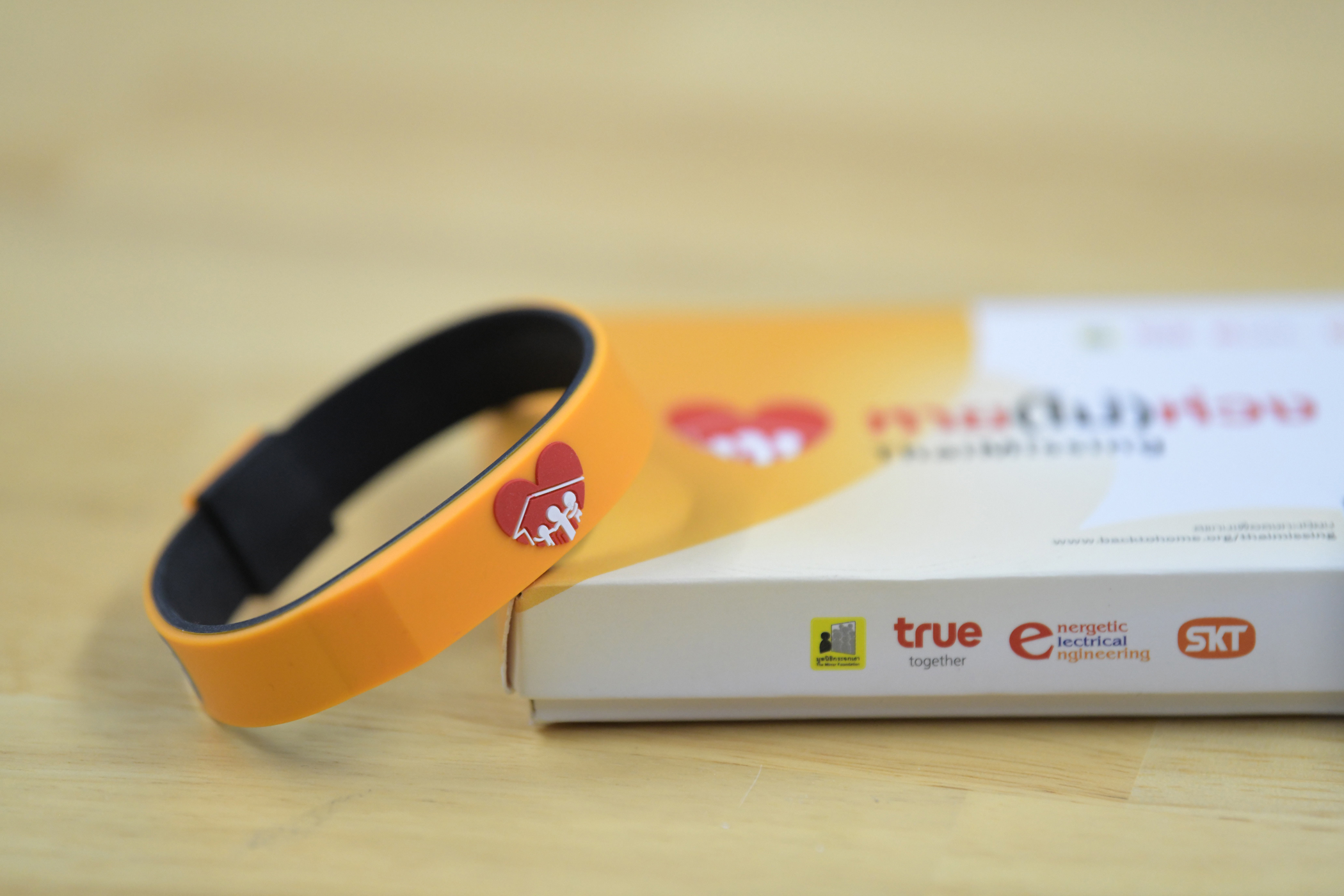
หลังจากที่ทุกฝ่ายช่วยกันคิดอย่างรอบด้านพร้อมไปกับการใช้องค์ความรู้และประสบการณ์ รวมไปถึงการทดลองร่วมกันตลอดช่วงระยะเวลา 1 ปี ท้ายที่สุดจึงเลือกใช้อุปกรณ์ที่เรียบง่ายที่ไม่ต้องอาศัยเทคโนโลยีทันสมัย นั่นคือ ริสแบนด์หรือสายรัดข้อมือสีเหลือง ที่มีเพียงแต่มีสัญลักษณ์หัวใจ QR Code และหมายเลขสายด่วนและเลขรหัสขนาดเล็กที่พอสังเกตเห็นได้ แต่ทั้งหมดนี้ล้วนออกแบบมาจากความเข้าอกเข้าใจและเคารพของสิทธิของสวมใส่ในทุกมิติ
“ริสแบนด์นี้ผ่านการคิดและทดลองมาเยอะมาก ตั้งแต่เรื่องความแข็งแรงคงทนที่ต้องทำเป็นสองชั้น เรื่องไซส์ที่พอดีกับข้อมือที่มีขนาดต่างกัน ที่สำคัญคือเรื่องรูปลักษณ์โดยเลือกสีที่ผู้สวมใส่ต้องไม่รู้สึกแปลกแยก แตกต่าง สัญลักษณ์บนริสแบนด์ก็มีเพียงรูปหัวใจแต่สิ่งสำคัญคือเครื่องหมาย QR Code ที่เป็นสัญลักษณ์ที่สื่อสารให้คนสังเกตได้ว่าน่าจะต้องมีข้อมูลที่เกี่ยวข้องกับผู้ที่สวมไว้ เพราะยุคนี้เราต่างก็คุ้นชินกับการสแกนข้อมูลแบบนี้อยู่แล้ว”
นอกจากริสแบนด์แล้วยังมีป้าย QR Code ขนาดเล็กที่ใช้รีดติดเสื้อผ้าหรือใช้พกพาได้ ซึ่งเป็นอีกทางเลือกที่ยังคงคำนึงถึงความรู้สึกและเคารพศักดิ์ศรีความเป็นมนุษย์ของผู้สวมใส่ ไม่ให้รู้สึกถูกตีตราว่าเป็นบุคคลที่ต้องการการดูแลพิเศษ
ระบบการปกป้องข้อมูลส่วนบุคคลมีความสำคัญที่สุด
ริสแบนด์ทุกเส้นจำเป็นต้องลงทะเบียนข้อมูลของทั้งผู้สวมใส่และญาติหรือผู้ที่มีส่วนได้ส่วนเสียที่ติดต่อได้ในกรณีมีเหตุพลัดหลง ซึ่งเอกลักษณ์ยืนยันว่า ข้อมูลทั้งหมดนี้จะได้รับการปกป้องเป็นอย่างรัดกุม ตั้งแต่ระบบหลังบ้านที่ออกแบบมาอย่างดี และการจำกัดสิทธิ์ผู้เข้าถึงข้อมูลและใช้ตามวัตถุประสงค์อย่างเคร่งครัด แม้แต่เซิร์ฟเวอร์ก็เก็บรักษาดูแลที่มูลนิธิกระจกเงา
“ความปลอดภัยของข้อมูลเป็นสิ่งที่เราให้ความสำคัญที่สุด ระบบข้อมูลต่างๆ ผ่านการคิดและออกแบบมาอย่างรอบคอบ แม้ว่าจะต้องมีบุคคลมาช่วยทำงานหลังบ้านและประสานงาน แต่ก็มีการจำกัดสิทธิ์ผู้ที่เข้าถึงได้เป็นเพียงเจ้าหน้าที่ศูนย์ฯ 8 คนโดยใช้ข้อมูลเพื่อการตามหาคนหายเท่านั้น ในกรณีที่มีการสแกน QR Code ที่ริสแบนด์ จะมีข้อความขึ้นในจอมือถือว่า ‘บุคคลนี้ต้องการความช่วยเหลือ โปรดนำส่งสถานีตำรวจใกล้เคียง หรือติดต่อที่หมายเลขสายด่วนของศูนย์ข้อมูลคนหาย มูลนิธิกระจกเงา’ เท่านั้น ไม่สามารถระบุถึงตัวตนของผู้สวมใส่ได้” เอกลักษณ์ย้ำ
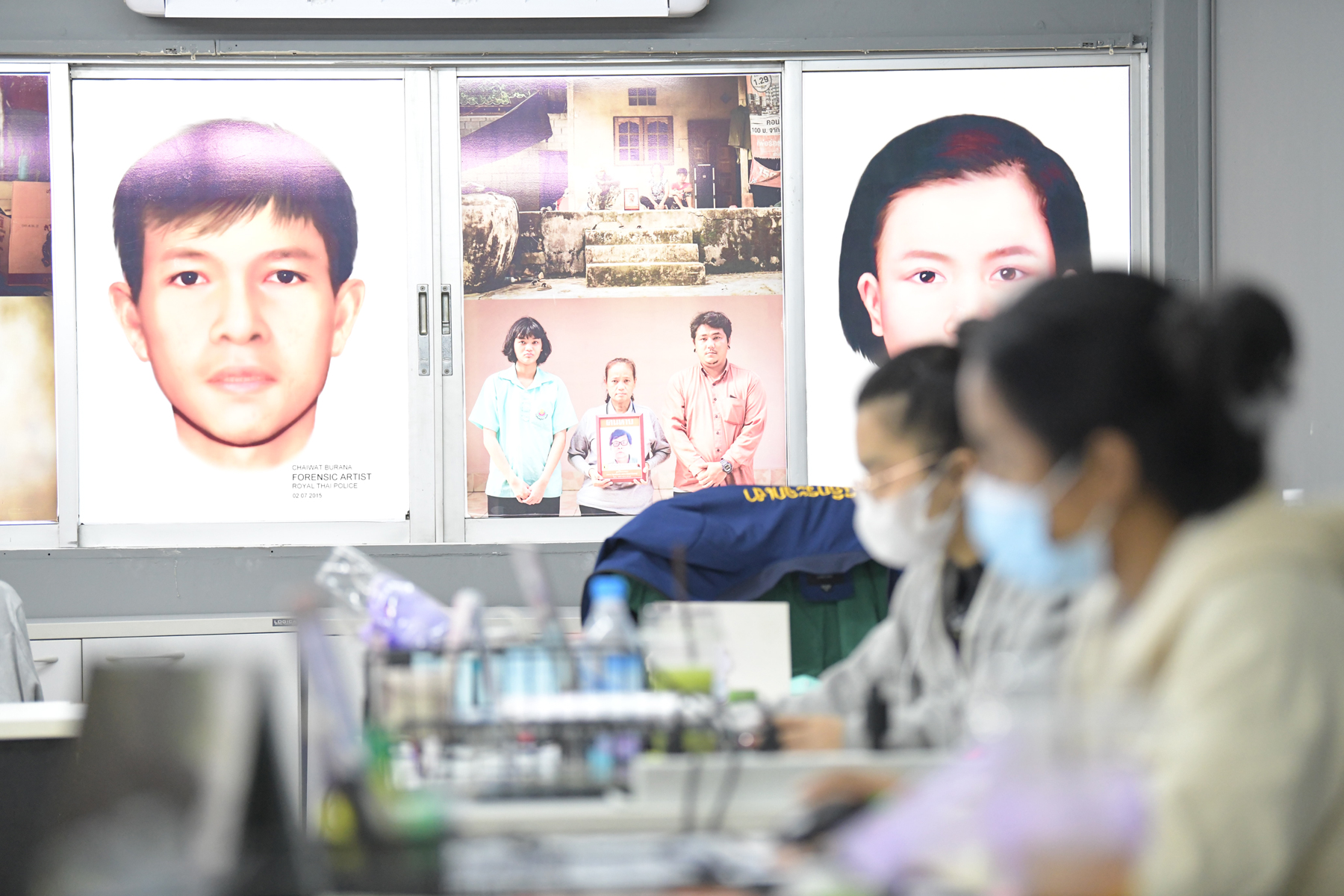
นอกจากนี้ วิธีการหลักในการติดตามคนหายจะเน้นไปที่งานเบื้องหลัง ไม่ว่าจะเป็นการตรวจสอบไปยังเครือข่ายต่างๆ มีการสืบสวน ติดตาม ลงพื้นที่ไปหาข่าว ส่วนวิธีการประกาศที่ต้องเปิดเผยข้อมูลผู้พลัดหลงมีเพียงจำนวนน้อยเท่าที่จำเป็น
“ประกาศคนหายที่เห็นเป็นเพียง 30% ของเคสที่รับแจ้งเท่านั้น และต้องได้รับการตรวจสอบและความยินยอมจากญาติ เราคำนึงถึงผลกระทบที่จะเกิดตามมาเสมอ ขอให้มั่นใจได้ว่าโครงการนี้รับผิดชอบต่อข้อมูลของทุกคนที่สมัครเข้ามา”
ศูนย์ข้อมูลคนหายที่ไม่มีเวลาปิดทำการ
อีกหนึ่งส่วนงานที่มีความสำคัญอย่างมากคือ งานหลังบ้านของศูนย์ข้อมูลคนหายที่คอยรับแจ้งเหตุและประสานงานอยู่ตลอด 24 ชั่วโมงทุกวัน เรียกว่าไม่มีเวลาปิดทำการ เพื่อช่วยดูแลจนกว่าผู้พลัดหลงจะได้กลับสู่บ้านอย่างปลอดภัย
“เมื่อพลเมืองดีสแกน QR Code ที่ริสแบนด์ ก็จะมีข้อความแจ้งมายังทีมงานเพื่อประสานให้การช่วยเหลืออย่างรวดเร็ว หรือส่วนมากพลเมืองดีก็มักจะโทรเบอร์สายด่วนที่อยู่บนริสแบนด์เข้ามาเลย ทีมงานก็จะรีบทำการตรวจสอบแบบเรียลไทม์ทันที” เอกลักษณ์อธิบาย
กระบวนการหลังได้รับแจ้งเหตุนั้น ทีมงานจะพูดคุยกับผู้แจ้งเหตุเพื่อขอโลเคชั่นและรูปถ่ายของผู้พลัดหลง รวมถึงรหัส PIN บนริสแบนด์ เพื่อเทียบเคียงตรวจสอบความถูกต้อง จากนั้นจึงแจ้งแนวทางในการช่วยเหลือต่อไป
“เมื่อทีมงานได้ระบุตัวตนของผู้พลัดหลงได้แล้ว ก็จะรีบติดต่อไปที่ญาติตามที่ให้ข้อมูลไว้ ซึ่งระหว่างนี้ก็จะขอให้พลเมืองดีช่วยดูแลก่อน แต่ถ้าไม่ได้ก็จะรีบประสานงานกับสถานีตำรวจที่ใกล้ที่สุดเพื่อให้ช่วยรับช่วงต่อก่อนที่จะญาติจะมา ซึ่งเราจะอยู่ประสานงานจนกว่าพวกเขาจะได้กลับบ้าน โดยไม่เปิดเผยข้อมูลส่วนบุคคลเลย”
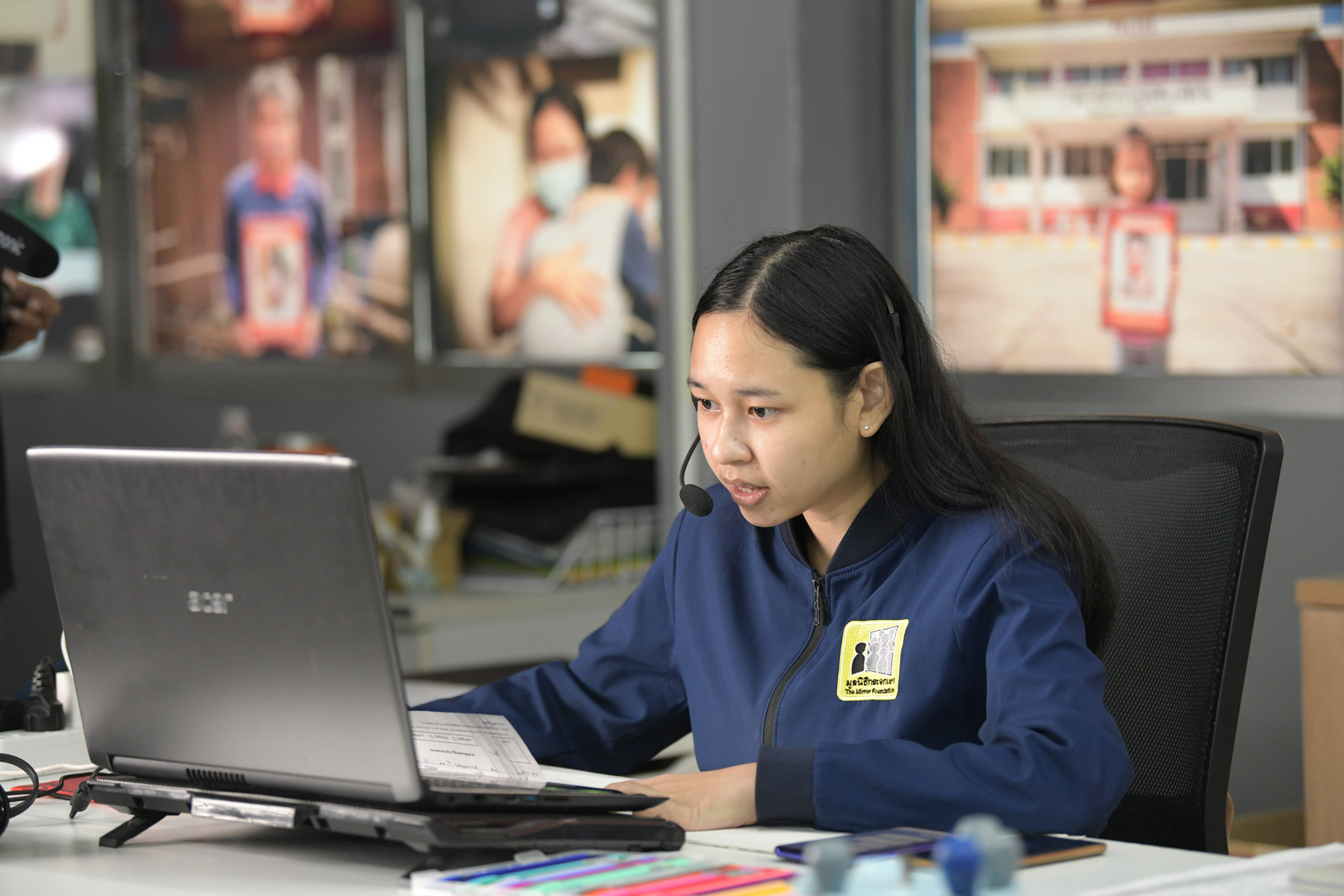
เราทุกคนมีส่วนช่วยดูแลปัญหาคนหายได้
ถึงตรงนี้ หลายคนคงเกิดคำถามว่า หากผู้พลัดหลงกลุ่มนี้ไม่ได้ใส่ริสแบนด์หาย(ไม่)ห่วงจะเป็นอย่างไร “ก็อาจเป็นเหมือนหลายๆ คนที่เรายังคงตามหาเขาอยู่” เอกลักษณ์ตอบ พลางมองไปรอบห้องทำงานที่มีประกาศของคนหายมากมาย
“ลองจินตนาการว่า ถ้ามีคุณยายคนหนึ่งพลัดหลงและหลงลืม กลับบ้านตัวเองไม่ได้ อาจมีพลเมืองดีเข้ามาช่วยคุณยาย บอกให้นั่งรอเพื่อเรียกตำรวจมาช่วยพาไป แต่คุณยายกลับตกใจเดินหนีต่อไปท่ามกลางอากาศที่ร้อนจัด ซึ่งอาจเป็นลม เสี่ยงกับอุบัติเหตุต่างๆ เพราะอยู่ท่ามกลางอันตรายได้ทุกรูปแบบ ถ้าได้รับบาดเจ็บคุณยายอาจถูกนำส่งโรงพยาบาล กลายเป็นผู้ป่วยไม่ทราบชื่อ โอกาสในก็ตามหาก็ยากยิ่ง และจะยากยิ่งกว่าหากเสียชีวิตและกลายเป็นศพนิรนาม
“ดังนั้น ความปลอดภัยคือสิ่งที่คุ้มค่าที่สุด ซึ่งริสแบนด์ของโครงการหาย(ไม่)ห่วงที่มีต้นทุนเส้นละ 170 บาทสามารถรักษาชีวิตของคนคนหนึ่งได้และพาเขากลับบ้านไปหาครอบครัวอย่างปลอดภัย ซึ่งทรูก็ได้ช่วยดูแลสนับสนุนส่วนนี้มาตลอด ผู้ลงทะเบียนจะไม่เสียค่าใช้จ่ายใดๆ และเราจัดส่งให้ถึงบ้านทุกคน” เอกลักษณ์สรุป
ปัญหาคนหายเป็นปัญหาสังคมที่เป็นสากล นั่นคือ ทุกประเทศในโลกเจอปัญหานี้ทั้งสิ้น เพียงแต่จะมีการบริหารจัดการต่อปัญหานี้อย่างไร เพราะในความจริงแล้วผู้สูงวัยที่มีอาการหลงลืม หรือบุคคลออทิสติกก็ยังต้องใช้ชีวิตเช่นเดียวกับคนปกติทั่วไป ดังนั้น สิ่งสำคัญที่สุดคือ การตระหนักรู้ปัญหาและความช่วยเหลือกันของคนในสังคม
“คนอาจมองว่าเราแก้ปัญหาที่ปลายเหตุ แต่ถ้าไม่รู้ปัญหาที่แท้จริงก็จะแก้ไม่ได้เลย จุดมุ่งหมายตอนนี้เราอยากให้สังคมตระหนักต่อปัญหาคนหาย เพราะทุกคนมีส่วนร่วมในภารกิจนี้ได้ จากการทำงานที่เราเจอคนหายแทบทุกเคส มาจากที่คนในสังคมไม่นิ่งดูดาย ช่วยกันเป็นหูเป็นตาให้กัน และที่สำคัญคือรู้วิธีปกป้องตัวเอง เพื่อลดความเสี่ยงให้ได้มากที่สุด” เอกลักษณ์ทิ้งท้าย
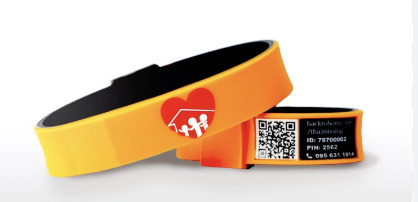
ชมวิดีโอ “ห้ามปัญหาคนหายไม่ได้ แต่อย่างน้อยก็มี “ริสแบนด์” ช่วยให้หายห่วงได้ | โครงการหาย(ไม่)ห่วง” ได้ที่ https://www.youtube.com/watch?v=ikjwMbtOIA4&ab_channel=TrueBlog
ข้อมูลเพิ่มเติมและลงทะเบียนโครงการหาย(ไม่)ห่วง https://wristband.thaimissing.org/home
“Hai Mai Huang” (“Missing, But Don’t Worry”) Project: Helping to Find Missing Persons with Wristbands: A Simple Innovation that Values a True Understanding of the Problem of Missing Elderly People
Elderly individuals are crucial members of families who still desire to lead meaningful and valuable lives. However, with age-related changes, families need to understand and find ways to ensure their safety, especially for seniors showing signs of memory loss and at risk of wandering.
Because missing persons incidents can happen to anyone, according to statistics from the Missing Persons Data Center, the Mirror Foundation, in the year 2023, there were a total of 2,200 reported missing person cases. The demographic group with the highest proportion of missing persons is the elderly. At present, they have become a significant population segment in Thai society according to statistics from the Department of Older Persons. In 2023, this group accounted for as much as 20.08% of the population, meeting the criteria for a “Complete Aged Society.”
Delving deeper, elderly individuals who go missing from their homes often suffer from memory loss or conditions like dementia, making tracking and assistance even more challenging. It is from this situation that the “Hai Mai Huang” (“Missing, But Don’t Worry”) project arises. This project is a collaboration between the Mirror Foundation and the private sector, aiming to provide care and attention to this vulnerable group.
Ekalak Lumchomkhae, the head of the Missing Persons Data Center at the Mirror Foundation, shares the story of the “Hai Mai Huang” (“Missing, But Don’t Worry”) project. Currently, with over 3,000 registered individuals in the past four years, the project has successfully safely returned over 40 missing persons home. Moreover, in the first three months of the year 2024, it has aided in reuniting 15 missing individuals with their families.
The problem of missing persons is bigger than one might think
Ekalak set the goal of his life to work for society from the time he graduated. Having interned as a lawyer, he realized that the quickest way to help people was by working within organizations for societal benefit. Consequently, the Shadow Foundation became his first and only workplace since 2004. Initially serving as a lawyer for the Missing Persons Data Center, which began its journey addressing issues of missing children due to being deceived into sex trafficking, forced labor, or even begging.
“As a lawyer, we tried to find ways to track missing persons more systematically. At that time, new tools emerged like newsletters and forwarded emails notifying about missing persons. Simultaneously, we worked on analyzing facts and investigating, coordinating with police officers, and tracking case outcomes using legal avenues.”
After working in missing persons tracking for a while, Ekalak realized that the issue stemmed from a myriad of causes beyond expectations. Consequently, the foundation adjusted its work and renamed the unit as the “Missing Persons Data Center,” which receives reports, provides consultations, searches for, and tracks missing persons of all types of diverse backgrounds. Ekalak then shifted to the role of leading this center.
With data available, the analysis reveals and exposes the real issue of missing persons
‘The fortunate thing is that we’ve had a database since 20 years ago. We have a system that records all missing person cases. This data allows us to understand the patterns of the problem clearly, such as the actual reasons why people go missing. And each period of time has its own differences,” Ekalak shared the knowledge gained from the work.
The gathering and analysis of data throughout have revealed that the issue of missing persons indeed fluctuates with economic and societal conditions. Over the past five years, the majority of missing persons belong to the elderly and individuals with mental health issues.
“The problem with this group of missing individuals is that they often cannot provide their own information. They can’t say who they are or where they’re from. This is a significant challenge in the process of providing assistance,” Ekalak explained.
The Missing Persons Data Center began to prioritize the issue of missing persons in this particular group earnestly. However, due to insufficient manpower, they had to wait for the right opportunity. Eventually, a generous donor, a technology-specialized company, stepped in to contribute their expertise in devising and initiating mechanisms for preventing and tracking missing persons. This led to the inception of a project specifically targeting elderly individuals with symptoms of memory loss, dementia, as well as individuals with mental illnesses and autistic individuals who are prone to wandering away from home, under the name of the “Hai Mai Huang” (“Missing, But Don’t Worry”) project.
“This project requires collaborative support and effort, especially in ensuring maximum public accessibility. True Corporation, a valuable partner and supporter of missing persons tracking initiatives since their involvement in the True Academy Fantasia program, where they contributed donations to the Shadow Foundation, has joined forces to make this project a reality. They have also utilized their expertise to raise awareness widely,” Ekalak remarked.
It’s impossible to completely eradicate the problem of missing persons, but must have mechanisms to help find them
“If we can minimize the time a person spends away from home and help them return home as quickly as possible, it will increase the safety for the missing individuals,” Ekalak explained the initial thought process. Before the team at the Missing Persons Data Center, the Mirror Foundation, and project partners pooled their ideas, resulting in the collaborative mechanisms of the “Hai Mai Huang” project:
- Practical tools: Devices that serve as symbols of assistance and can identify missing persons. Each piece must be registered and accessible to both the wearer and their relatives.
- Privacy protection: Personal information of both the wearer and registered family members will be stored in a tightly controlled database accessible only to the Missing Persons Data Center, serving as the central hub for notification, data verification, and coordination.
- Community engagement: Public awareness encourages people to observe, report incidents, take care of each other, and raise awareness of the issue. If there are individuals at risk of going missing within a family, they can register with the project.
The details of the process that led to the development of this project were not straightforward because each step relied on knowledge, experience, diverse perspectives, and genuine understanding.
Simple innovations stemming from understanding
When the team started looking for key devices to serve as communication symbols, indicating that the wearer needs assistance, they began by seeking benefits from modern technology available at the time. Whether it was RFID (Radio Frequency Identification) systems, GPS systems, or Smart Watches with SIM cards, modern devices often came with the inconvenience of needing to be recharged, which became a barrier to wearing them consistently.
“Because whenever the device is removed from the hand, there is a risk that the wearer may not put it back on like before. Devices that require removal for charging are therefore not very suitable,” Ekalak explained.
After everyone contributed their diverse perspectives and utilized their knowledge and experiences, along with collaborative experimentation over the span of a year, we ultimately decided to opt for a simple device that doesn’t rely on modern technology. That’s a yellow wristband, adorned only with a heart symbol, a QR code, and visible emergency contact information. All of this was designed with empathy and respect for the wearer’s rights in mind in every dimension.
This wristband has undergone extensive thinking and experimentation, from ensuring its durability with dual-layer construction to accommodating different wrist sizes. The crucial aspect was its appearance, selecting a color that doesn’t make the wearer feel alienated or different. While the symbol on the wristband is simply a heart, the most important element is the QR code, which communicates to observers that there must be pertinent information related to the wearer. In today’s era, we’re all familiar with scanning for information in this manner.
In addition to the wristband, there are also small-sized QR code tags that used for ironing onto clothing or carried, offering another option that continues to prioritize the wearer’s dignity and humanity, ensuring they don’t feel stigmatized as someone needing special care.
The data protection system is of utmost importance
All wristbands require registration of both the wearer’s and their contact person’s information in case of emergencies. The identity confirms that all data is tightly protected, from well-designed backend systems to restricted access and usage rights, even the servers are securely maintained by the Mirror Foundation.
“Data security is our top priority. Our data systems are meticulously thought out and designed. Even though personnel are involved in backend operations and coordination, access is strictly limited to only 8 center staff members, who utilize the data solely for missing person searches. In the event of scanning a QR code on the wristband, a message will appear on the mobile screen stating, ‘This individual requires assistance. Please take them to the nearest police station or contact the hotline of the Missing Persons Data Center, the Mirror Foundation. No personal identity of the wearer can be disclosed,” Ekkalak emphasized.
Furthermore, the primary method of tracking missing persons focuses on backend work, including network checks, investigations, field tracking, and news coverage. The methods for publicly announcing missing persons are kept to the necessary minimum.
“Only 30% of reported cases are publicly announced, and they require verification and consent from relatives. We always consider the potential consequences. Rest assured, this project is accountable for the data of all registered individuals.”
The Missing Persons Data Center operates around the clock without closing hours
Another crucial part of the operation is the back-end work of the Missing Persons Data Center, which receives reports and coordinates activities 24 hours a day, every day, with no closing hours, to ensure the safe return of missing individuals.
“When a compassionate individual scans the QR code on the wristband, a message is sent to our team for prompt coordination of assistance. Alternatively, most compassionate individuals tend to call the hotline number provided on the wristband directly, and our team promptly verifies the information in real-time,” explained Ekkalak.
Upon receiving a report, the team engages with the reporting party to request location and photos of the missing individual, along with the PIN code on the wristband for verification. Then, they provide guidance on further assistance.
“When our team has identified the missing person’s identity, we promptly contact the provided relatives. In the meantime, we request assistance from community members for temporary care. If unavailable, we quickly coordinate with the nearest police station for interim support until the relatives arrive. We continue our coordination until they safely return home, without disclosing any personal information.”
We all have a part in addressing the issue of missing persons
Up to this point, many people may wonder what would happen if individuals in this group don’t wear the wristband. “It could be like many others whom we are still searching for,” Ekaklak responded, gesturing towards the office space filled with missing persons posters.
“Imagine if there’s an elderly person who goes missing and gets lost. Unable to find their way back home, a kind-hearted individual might step in to help. They instruct the elderly person to wait while they call the police for assistance. However, in their confusion, the elderly person may wander off into the scorching heat, risking various accidents due to being exposed to danger in all forms. If they sustain injuries, they may be rushed to the hospital as an unidentified patient. Finding them becomes even more difficult, and it becomes even more challenging if they pass away and become an unidentified body.”
“So, safety is the utmost priority. The project’s wristbands, which cost only 170 baht per unit, can save a person’s life and safely reunite them with their family. True has been supporting this initiative all along. Registrants incur no expenses, and we deliver the wristbands to everyone’s doorstep,” summarized Ekkalak.
The issue of missing persons is a global societal problem. Every country in the world faces this issue. However, the key lies in how we manage and address this problem. Because in reality, elderly individuals with dementia or autistic individuals still deserve to live their lives just like any other ordinary person. Therefore, the most important thing is awareness of the problem and the mutual assistance of people in society.
“People might think that we are solving the problem at its root, but if we don’t understand the real problem, we won’t be able to solve it at all. Our current goal is to raise awareness in society about the issue of missing persons because everyone has a role to play in this mission. From our work, we’ve found that almost every missing person case stems from members of society not being vigilant enough. Let’s lend each other our ears and eyes, and most importantly, let’s learn how to protect ourselves to minimize risks as much as possible,” concluded Ekkalak.
Watch the video “Unable to Solve the Problem of Missing Persons, but at Least There’s a ‘Wristband’ to Help. “Hai Mai Huang” (“Missing, But Don’t Worry”) Project at https://www.youtube.com/watch?v=ikjwMbtOIA4&ab_channel=TrueBlog
For more details and registration for the “Hai Mai Huang” (“Missing, But Don’t Worry”) Project, visit

